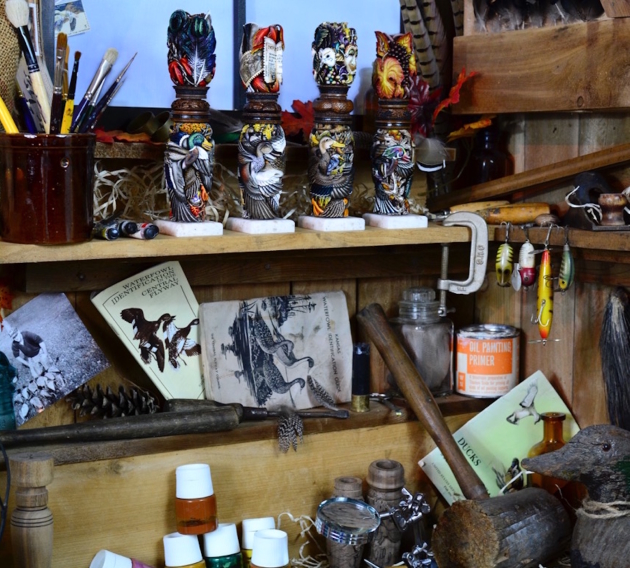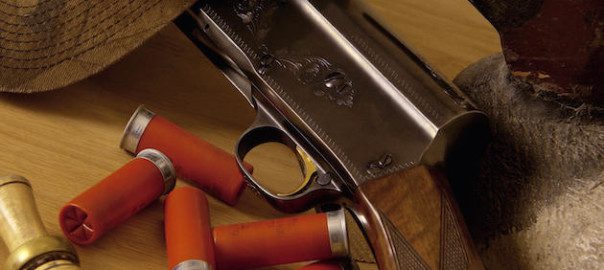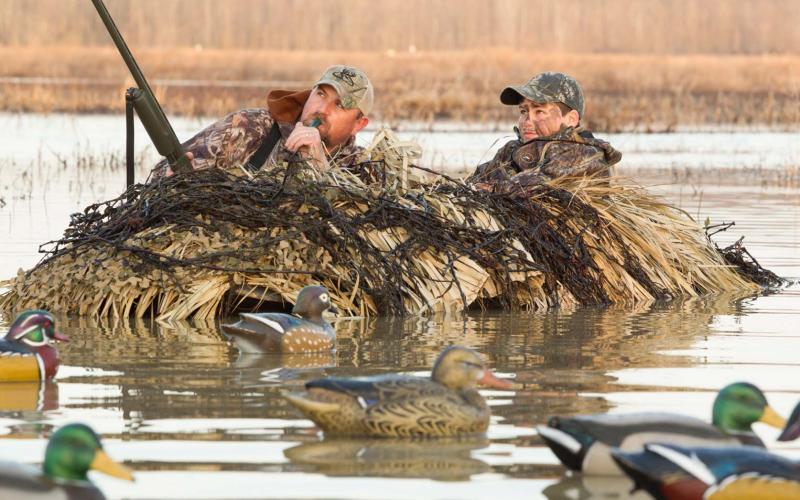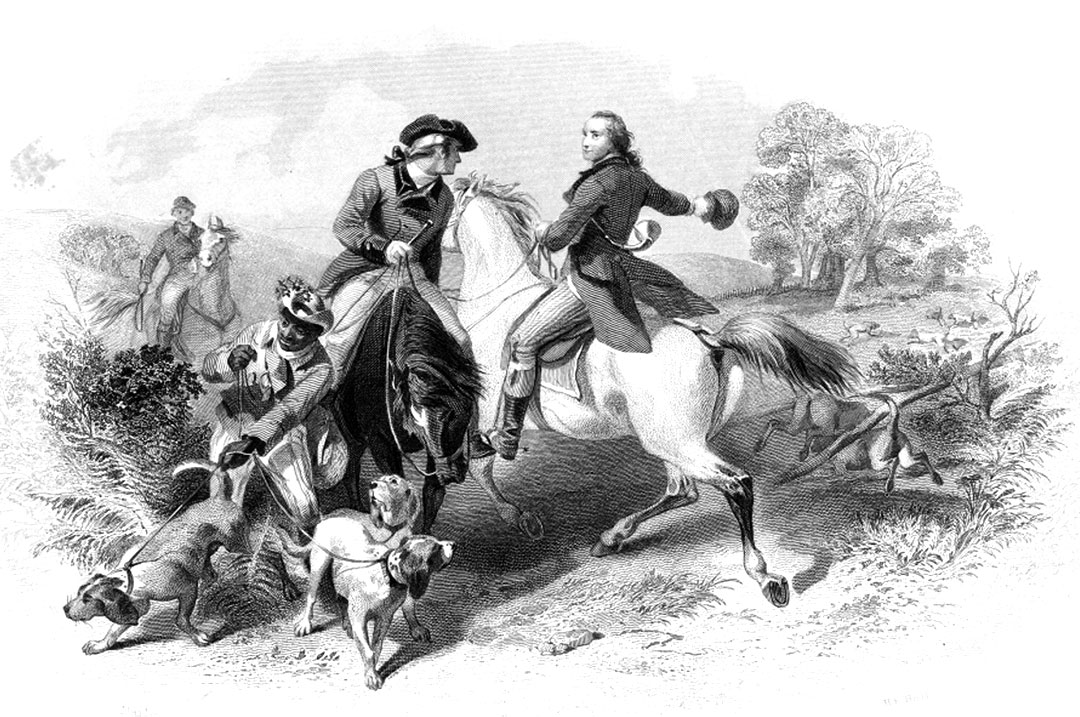From the January/February 2017 issue of Sporting Classics.
Chuck Palahniuk once wrote, “We all die. The goal isn’t to live forever; the goal is to create something that will.” The quote could well be called the Artists’ Creed for its depth and insight. Once an artist achieves a modicum of success, their thoughts turn from simply paying the bills to creating something truly unique, personal, and, ultimately, eternal.
While Joe Bucher is still a reasonably young man, and while he’s far from through carving duck calls, his days of make-a-lot-quick are behind him. He’s made his mark, even had a call enshrined in Ducks Unlimited’s waterfowl museum inside the Bass Pro Shops Pyramid in Memphis, Tennessee. He knows how he wants to cap his creative career, and for duck hunters and those who love wood carving, it’s an awe-inspiring idea.
Bucher began carving calls in high school with Marshland Game Calls, located in his hometown of Kansas City, Missouri. When he went to a local gun shop to purchase one of the company’s calls, the shop owner told him they were out of stock and suggested he contact Marshland’s owner, Dale Largent, directly to see about buying one. Bucher did, and Largent invited him to visit his call shop.
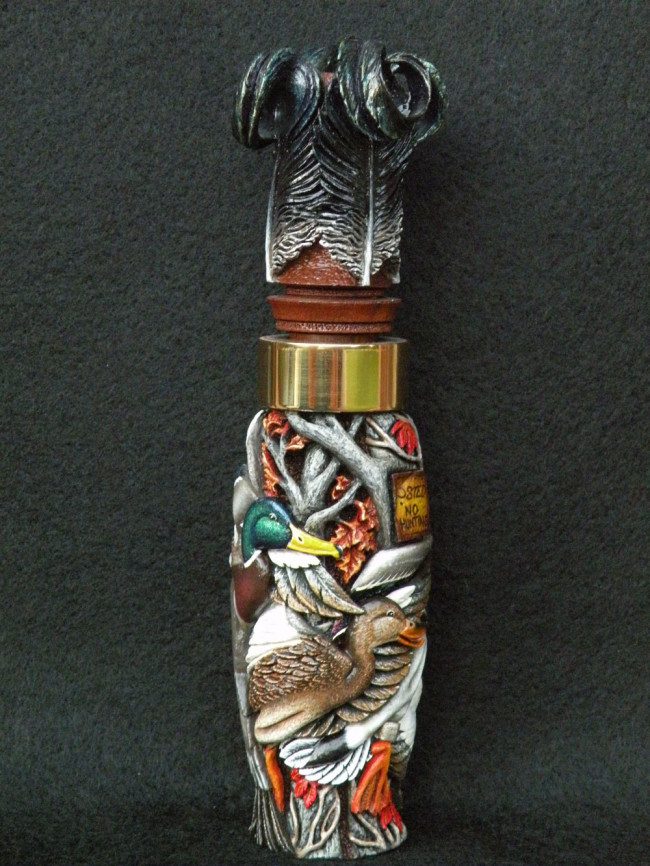
Each Heritage game call is truly one of a kind . . . and not for sale!
Largent gave Bucher a tour of his basement workspace, complete with turning lathes that had been retasked to create duck calls. Bucher spotted several calls painted in a “folk-artsy” style and thought he would like to try his hand at doing the same.
The day ended with Largent giving Bucher a few calls to practice painting, which he quickly finished and brought back to Largent ready to sell. Largent bought the calls and gave Bucher more to work on. Bucher was soon providing his gracious benefactor with a large enough supply to take to outdoor shows and sell.
“The rest is kind of history,” Bucher said. “It got to the point that I was doing tons of carving for him and started putting bands on a lot of his calls.”
Largent took the finished calls to Minnesota to sell at an outdoor show in Minneapolis, “loading his car completely full and selling them all,” Bucher said. Largent returned, gave Bucher another order, and on they went for some time. Bucher eventually asked if Largent would mind if he struck out on his own. Largent’s answer: Go forth and prosper.
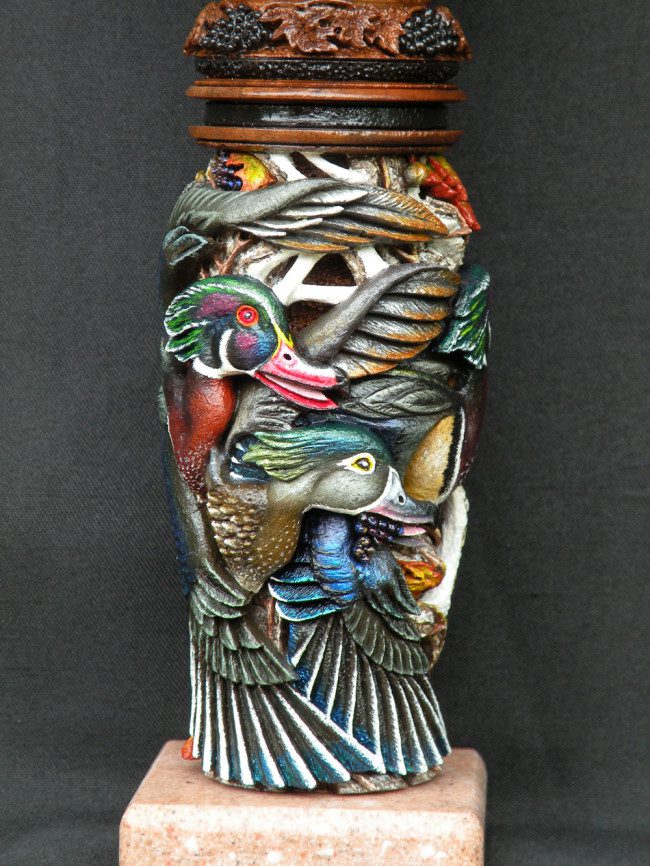
Two wood ducks dining on grapes.
From there, Bucher was off to the races. He began showcasing his work in art galleries—at one point more than 100 featured his creations all across the country. Looking to move into mass production, Bucher began noticing office supplies with laser engraving on them, which set him to thinking: Why not use that same technology with duck calls?
“We tried to find a laser company that could do duck calls. The problem we had doing this is the duck calls were cylindrical, and they were also tapered. The engraving machines at that time [mid-1990s] didn’t have the software to compensate for the taper of them. The roundness of the call itself was even a challenge.”
A Canadian craftsman eventually created a matrix to hold the call as it spun and the accompanying software to account for the taper, allowing Bucher to realize his vision. The first few Bucher got back “weren’t real great,” but he was able to have a pair of flying mallards emblazoned on a call. Following through on his years-long passion, he headed for Tennessee, hoping against hope the new calls could become associated with Ducks Unlimited.
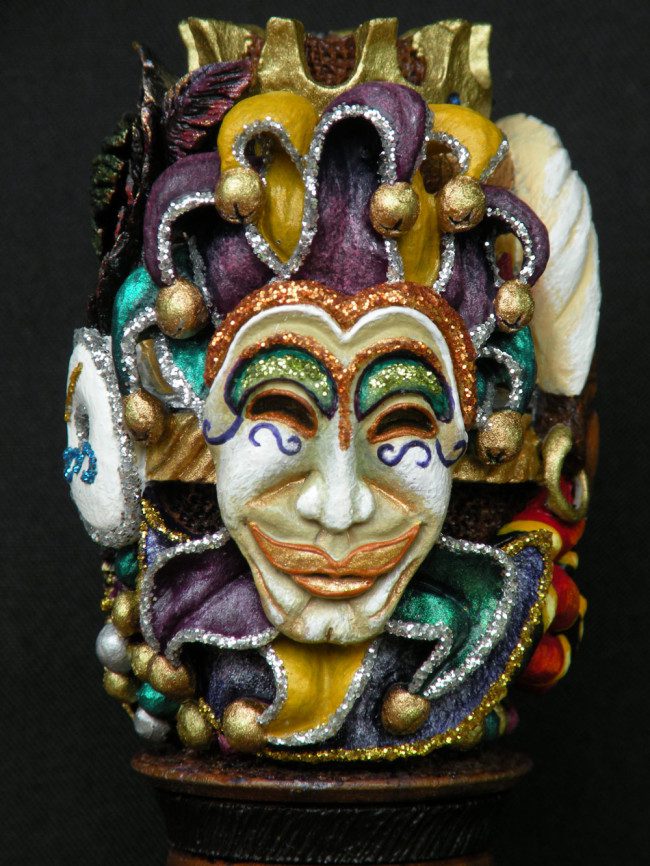
A Mardi Gras mask adorns the Louisiana-themed call.
“I painted it up and actually drove down to Memphis and talked to Gary Goodpaster, who was the head of product selection down there at the time,” Bucher said. “Gary said they had already picked their products for the year, but they would keep it in mind.”
The call stayed in Memphis, and Bucher went home. A few months went by before an out-of-the-blue call came from Goodpaster.
“He said, ‘Hey, Joe, one of our vendors dropped out. Would you be interested in doing this?’”
The question was practically rhetorical. No way Bucher was going to let the opportunity slip from his grasp.
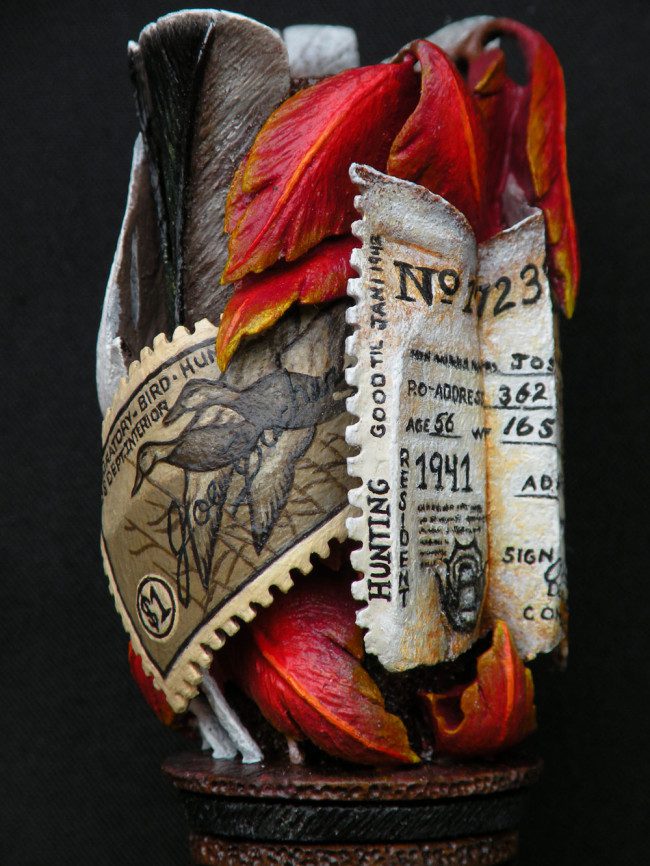
A miniature duck stamp and hunting license.
DU started off with a few hundred of Bucher’s calls, selling them immediately—immediately immediately. The first run was gone in a week, with orders for 800 more already placed by the week’s close. DU requested 2,000 more calls for the second batch.
“We ended up selling 4,000 calls—4,000 or 4,500 calls—the first year to national,” Bucher said. “We sold 4,500,” he later recalled, “because Gary even talked about doing a second edition.”
There were lots of mallard engravings. Some Canada geese. Dogs, particularly Labs, were popular. The partnership saw between 4,000 and 4,500 calls sold each year for nine years before the national deal ended.
“Then they ended up dropping the line, because they do that. They were not going to carry you forever because they’re looking for new stuff,” Bucher said. “But then we started doing lots of work with the states; at one time, we had half the states in the country doing projects with us. Plus, a zillion independent chapters.”
Bucher also had arrangements with Caterpillar, Bass Pro Shops, and more.
“This was going on in the mid-1990s up until about the mid-2000s.”
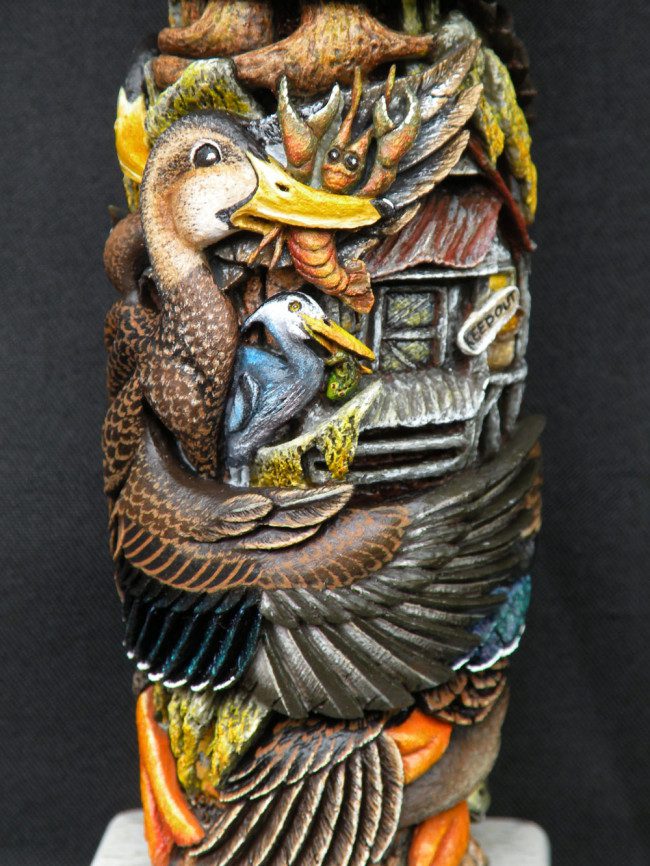
A Cajun-themed call, complete with crawdads and an old hunting shack.
However, like the original deal with Ducks Unlimited, nothing lasts forever. The terrorist attacks of September 11, 2001, and the subsequent economic downturn forced many of Bucher’s sales relationships to end. Mom-and-pops had to close up shop; major retailers like Cabela’s and Bass Pro Shops had to decline orders—several different pieces of the same crumbling pie, leaving Bucher with only two options: adapt, or die.
“I knew I had to flip over to do something really, really different,” Bucher said. “I wasn’t sure exactly what I was going to do. I still had a lot of orders for just carved calls. But I knew that wasn’t really enough to wow people.”
An idea began to take shape between 2011 and 2012: elaborately carved and colored duck calls, one representing each species of waterfowl in North America. And not just the species proper, but all the trappings and traditions that make each duck, goose, or swan an intrinsic part of the landscape it inhabits. (Maybe swans; he’s not sure about them just yet.)
“They’re all going to be very unique, and they’re all going to be themed,” Bucher said. “The mottled duck is a Louisiana theme. The black duck is a New England theme. They’re all going to be themed, and the older the theme, the more vintage they are.”
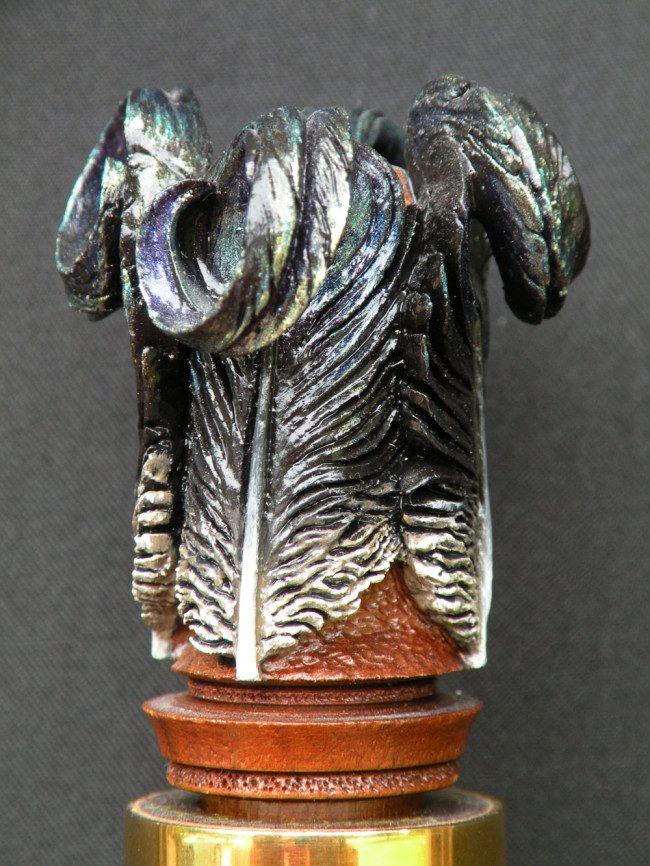
Talk about attention to detail.
Several of these calls are already completed—to the amazement of all who have seen them. From top to bottom, no part of Bucher’s “canvas” is wasted.
What began as a new direction for Bucher’s career ultimately became its capstone, and with it came a very important decision. He could sell the calls for a small mint each, but that would split up the collection. The time-intensiveness and unique design of each call prohibits mass production. So how would he market these calls?
The answer? Bucher’s one-of-a-kind calls will not be for sale. Each will permanently stay with its brethren, eventually becoming part of a traveling display case that will go to the various wildlife expos across the country. Attendees will get to see each call up close—they’re meant to be enjoyed by everyone, not locked away in one or two collectors’ homes.
That’s not to say some haven’t already tried to coax them away from Bucher. It takes a lot of willpower and determination to pass up $20,000-plus for a single call, but it’s happened multiple times already. Bucher is determined to keep the family together, so to speak, and is willing to pass up the money in order to create a collection that lives on long after he’s gone. After all, as another famous saying on mortality goes, “You can’t take it with you when you go.”

